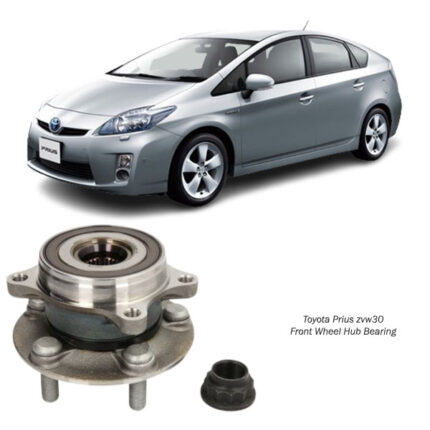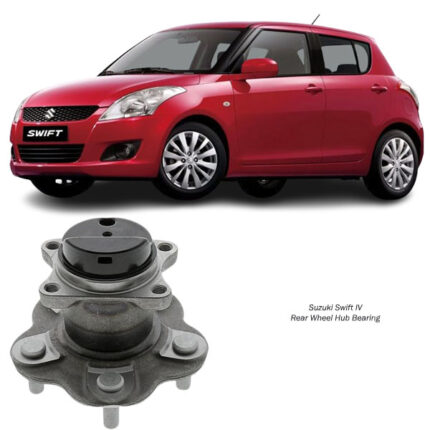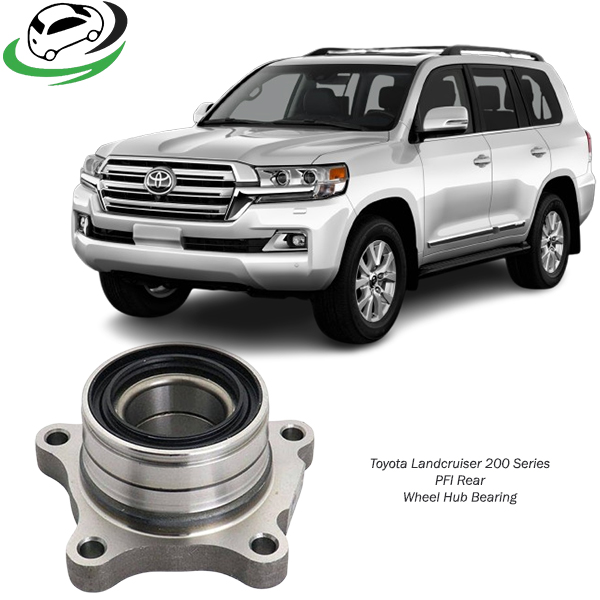-3%
Get Toyota Land Cruiser 200 Series Rear Wheel Hub Bearing 42450-60070
The rear wheel hub bearing is a vital component of a vehicle’s suspension and drivetrain system, playing a critical role in ensuring safe and efficient operation. While often overlooked, the wheel hub bearing is essential for providing smooth wheel rotation, maintaining proper alignment, and supporting the weight of the vehicle. This comprehensive guide will delve into the function of rear wheel hub bearings, their benefits, maintenance tips, and the signs that indicate a need for replacement.
What is a Rear Wheel Hub Bearing?
A rear wheel hub bearing consists of a set of steel balls or rollers enclosed within a metal casing, allowing the wheel hub to rotate smoothly around the axle. The bearing is mounted inside the wheel hub and connects the wheel to the vehicle’s axle and suspension system. This component is designed to handle both radial (vertical) and axial (horizontal) loads, providing stability and support during operation.
Function of Rear Wheel Hub Bearings
- Support the Wheel Assembly The primary function of the rear wheel hub bearing is to support the weight of the vehicle and the forces exerted on the wheel assembly during acceleration, braking, and cornering. The bearing enables the wheel to rotate freely while providing the necessary support for the vehicle’s weight.
- Facilitate Smooth Wheel Rotation The design of the wheel hub bearing allows for minimal friction between the rotating wheel and the stationary axle. This smooth rotation is essential for efficient vehicle performance, contributing to better fuel economy and enhanced handling.
- Maintain Wheel Alignment Proper alignment of the wheels is crucial for safe driving. Rear wheel hub bearings help maintain correct wheel alignment, preventing uneven tire wear and improving vehicle stability. Misalignment can lead to reduced performance, increased tire wear, and difficulty in steering.
- Absorb Road Shock and Vibration The rear wheel hub bearing plays a role in absorbing shocks and vibrations from the road. This is particularly important when driving over rough terrain or uneven surfaces, as it helps provide a smoother ride for passengers and reduces wear on other suspension components.
- Enable Anti-lock Braking System (ABS) Functionality In vehicles equipped with an ABS, the wheel hub bearing often contains a speed sensor that monitors wheel rotation. This information is crucial for the ABS to function correctly, preventing wheel lock-up during hard braking and enhancing overall safety.
Benefits of Using Genuine Rear Wheel Hub Bearings
- Improved Durability and Longevity Genuine rear wheel hub bearings are designed to meet the exact specifications set by the vehicle manufacturer, ensuring optimal performance and durability. These bearings are made from high-quality materials and undergo rigorous testing to withstand the demands of daily driving. Choosing genuine bearings helps prevent premature wear and tear, extending the lifespan of your vehicle’s wheel hub assembly.
- Enhanced Safety and Performance Using genuine rear wheel hub bearings ensures safe and reliable operation. These bearings provide smooth wheel rotation and proper alignment, reducing the risk of handling issues, vibrations, or unexpected failures while driving. Ensuring the quality of your wheel bearings contributes to overall vehicle safety, especially during emergency maneuvers.
- Reduced Maintenance Costs Genuine rear wheel hub bearings require less frequent replacement than aftermarket alternatives. By investing in high-quality bearings, vehicle owners can save money on maintenance and repairs over time, as genuine parts are less likely to fail or require additional servicing.
- Better Performance under Extreme Conditions Genuine rear wheel hub bearings are engineered to perform reliably under a range of driving conditions, from city streets to highways and off-road environments. They are designed to resist corrosion, wear, and temperature fluctuations, ensuring consistent performance even in extreme situations.
- Optimal Fit and Compatibility Genuine bearings are specifically designed for each vehicle model, ensuring a perfect fit and compatibility with the vehicle’s suspension and drivetrain components. This helps avoid the issues associated with poorly fitting aftermarket parts, such as misalignment, increased friction, and premature wear.
Maintenance Tips for Rear Wheel Hub Bearings
- Regular Inspections Routine inspections of the rear wheel hub bearings should be part of your vehicle’s maintenance schedule. Check for any signs of wear or damage, including roughness when rotating the wheel by hand or unusual noises during driving.
- Listen for Unusual Noises Pay attention to any grinding, humming, or growling noises coming from the rear wheels while driving. These sounds can indicate bearing wear or failure, and immediate inspection is necessary to prevent further damage.
- Check for Vibration or Steering Issues If you experience vibrations in the steering wheel or seat while driving, it may indicate a problem with the rear wheel hub bearings. Addressing this issue promptly can help prevent further damage to other suspension components.
- Monitor Tire Wear Uneven tire wear can be a sign of misalignment, which may be caused by worn rear wheel hub bearings. Regularly inspecting your tires for wear patterns can help identify issues with the bearings or alignment early on.
- Maintain Proper Lubrication Most modern wheel hub bearings are pre-greased and sealed, requiring little to no maintenance. However, for vehicles with non-sealed bearings, regular lubrication is essential. Check the manufacturer’s recommendations for maintenance intervals and proper lubrication techniques.
Signs of a Failing Rear Wheel Hub Bearing
- Unusual Noises One of the first signs of a failing rear wheel hub bearing is a change in noise. Grinding, rumbling, or humming noises that intensify with speed may indicate that the bearing is worn or damaged. If the noise changes when turning, it could suggest a specific issue with the bearing on one side.
- Vibration or Instability A failing wheel hub bearing can cause vibration in the rear of the vehicle, which may be felt in the steering wheel or seat. This instability can affect handling and lead to a dangerous driving situation, especially at high speeds.
- Excessive Play in the Wheel If you notice excessive movement or play in the rear wheel when you attempt to shake it up and down or side to side, it may indicate a worn or damaged wheel hub bearing. This play can lead to misalignment and increased wear on tires and suspension components.
- Visible Damage or Rust Inspecting the rear wheel hub and bearing for signs of rust, damage, or fluid leakage is essential. Any visible issues should be addressed promptly to prevent further damage and ensure safe operation.
- Warning Lights In vehicles equipped with ABS or traction control systems, warning lights may illuminate on the dashboard if there is an issue with the wheel hub bearings or the speed sensors associated with them. If these warning lights appear, have the vehicle inspected as soon as possible.
Replacement of Rear Wheel Hub Bearings
- When to Replace If your inspection reveals signs of wear, noise, or instability, it’s crucial to replace the rear wheel hub bearings immediately. Continuing to drive with faulty bearings can lead to more severe issues, including complete bearing failure, which can result in loss of control while driving.
- Choosing Quality Replacement Bearings When replacing rear wheel hub bearings, opt for genuine parts from the vehicle manufacturer or high-quality aftermarket alternatives that meet or exceed OEM specifications. Ensuring compatibility and quality will help maintain the performance and safety of your vehicle.
- Professional Installation Replacing rear wheel hub bearings can be a complex task that requires specialized tools and expertise. While some skilled DIY enthusiasts may undertake this job, it is often recommended to have it done by a qualified mechanic. Proper installation is crucial to ensure the longevity and reliability of the new bearings.
- Alignment Check After replacing the rear wheel hub bearings, it’s advisable to have the wheel alignment checked. Proper alignment ensures even tire wear and optimal handling, contributing to the overall performance of the vehicle.
- Break-in Period New wheel hub bearings may require a break-in period. During this time, pay close attention to any unusual noises or vibrations, and return to the mechanic if any issues arise.
Conclusion
Rear wheel hub bearings are critical components of a vehicle’s suspension and drivetrain systems, providing essential support, smooth rotation, and stability. Regular maintenance and timely replacement of worn bearings are vital to ensure safe driving and optimal vehicle performance. By investing in genuine rear wheel hub bearings and adhering to proper maintenance practices, vehicle owners can enhance their safety on the road, prolong the lifespan of their vehicle, and enjoy a smoother, more reliable ride.
Follow us on Facebook for more parts.



